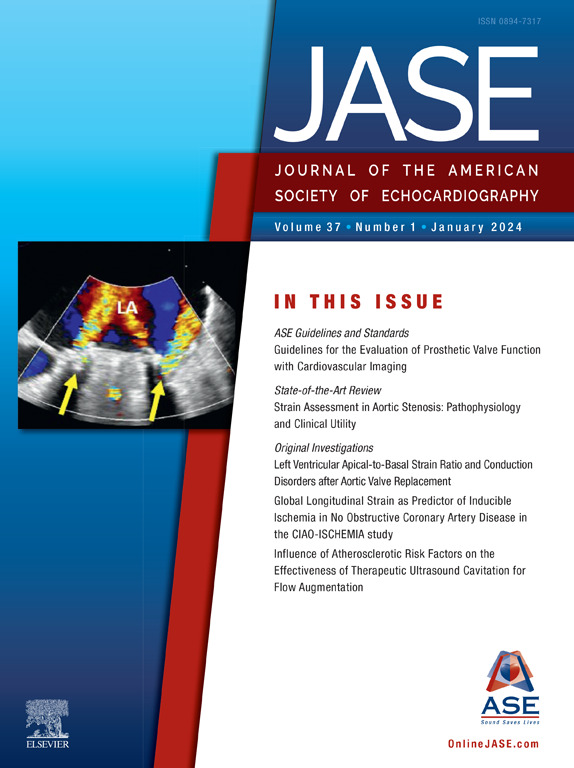Exercise Echocardiography for Risk Stratification in Unexplained Dyspnea: The Incremental Value of the Mean Pulmonary Artery Pressure/Slope
IF 6
2区 医学
Q1 CARDIAC & CARDIOVASCULAR SYSTEMS
Journal of the American Society of Echocardiography
Pub Date : 2025-10-01
DOI:10.1016/j.echo.2025.06.007
引用次数: 0
Abstract
Background
Patients with unexplained dyspnea and an elevated mean pulmonary artery pressure (mPAP)/cardiac output (CO) slope on invasive hemodynamic assessment during exercise have worse clinical outcomes. The aim of this study was to evaluate the incremental prognostic value of the noninvasive mPAP/CO slope in addition to heart failure with preserved ejection fraction (HFpEF) probability scores and diastolic stress testing in patients with unexplained dyspnea.
Methods
In a multicenter cohort study involving six Belgian dyspnea clinics, patients with unexplained dyspnea underwent exercise echocardiography for mPAP/CO slope assessment. Positive HFpEF scores were defined as HFA-PEFF (Heart Failure Association pretest probability echocardiography, functional testing, final diagnosis) score ≥ 5 and H2FPEF (heavy, hypertensive, atrial fibrillation, pulmonary hypertension, elder, filling pressure) score ≥ 6. The outcome evaluated was a composite of all-cause mortality or heart failure hospitalization.
Results
Among 2,452 patients (mean age, 63 ± 15 years; 53% women), mPAP/CO slope > 3.5 mm Hg · L−1 · min−1 best predicted adverse outcomes. The prognostic value of the mPAP/CO slope was greater in patients with negative HFpEF scores than in those with positive scores (interaction P = .02). The mPAP/CO slope remained independently prognostic after adjustment for N-terminal pro–B-type natriuretic peptide (hazard ratio [HR], 2.26; 95% CI, 1.33-3.82) and for HFpEF scores and diastolic stress testing (HR, 1.99; 95% CI, 1.37-2.88), whereas exercise tricuspid regurgitant velocity did not. Both HFpEF score–negative patients with slope > 3.5 mm Hg · L−1 · min−1 (HR, 2.99; 95% CI, 1.81-4.95) and HFpEF score–positive patients (HR, 6.29; 95% CI, 4.25-9.31) showed significantly higher risk compared with HFpEF score–negative patients with slope ≤ 3.5 mm Hg · L−1 · min−1.
Conclusions
The mPAP/CO slope, unlike exercise tricuspid regurgitant velocity, adds prognostic value beyond natriuretic peptides, HFpEF scores, and diastolic stress testing, identifying high-risk patients with exercise-induced hemodynamic abnormalities who may benefit from invasive confirmation and closer follow-up.
运动超声心动图对不明原因呼吸困难的危险分层:mPAP/CO斜率的增量值。
背景:运动过程中有创性血流动力学评估中出现原因不明的呼吸困难和平均肺动脉压/心输出量(mPAP/CO)斜率升高的患者临床预后较差。目的:评价无创mPAP/CO斜率在保留射血分数(HFpEF)概率评分和舒张压力测试心力衰竭患者的增量预后价值。方法:在一项涉及6家比利时呼吸困难诊所的多中心队列研究中,不明原因呼吸困难患者接受运动超声心动图进行mPAP/CO斜率评估。HFA-PEFF评分≥5或H2FPEF评分≥6为阳性,否则为阴性。评估的结果是全因死亡率或心力衰竭住院的综合结果。结果:2452例患者(年龄63±15岁,53%为女性),mPAP/CO斜率为3.5 mmHg.L-1。Min最能预测不良后果。mPAP/CO斜率在HFpEF评分为阴性的患者中的预后价值大于评分为阳性的患者(相互作用p=0.02)。调整NT-proBNP (HR 2.26, 95% CI: 1.33-3.82)、HFpEF评分和舒张压力测试(HR 1.99, 95% CI: 1.37-2.88)后,mPAP/CO斜率仍然是独立的预后指标,而运动三尖瓣反流速度则不是。两例HFpEF评分均为阴性,斜率为3.5 mmHg.L-1。min (HR 2.99 [95%CI 1.81-4.95])和HFpEF评分阳性患者(HR 6.29 [95%CI 4.25-9.31])的风险明显高于斜率≤3.5 mmHg.L-1的HFpEF评分阴性患者。结论:与运动三尖瓣反流速度不同,mPAP/CO斜率在利钠肽、HFpEF评分和舒张压力测试之外增加了预后价值,可以识别运动引起血流动力学异常的高危患者,这些患者可能受益于有创确认和更密切的随访。
本文章由计算机程序翻译,如有差异,请以英文原文为准。
求助全文
约1分钟内获得全文
求助全文
来源期刊
CiteScore
9.50
自引率
12.30%
发文量
257
审稿时长
66 days
期刊介绍:
The Journal of the American Society of Echocardiography(JASE) brings physicians and sonographers peer-reviewed original investigations and state-of-the-art review articles that cover conventional clinical applications of cardiovascular ultrasound, as well as newer techniques with emerging clinical applications. These include three-dimensional echocardiography, strain and strain rate methods for evaluating cardiac mechanics and interventional applications.

 求助内容:
求助内容: 应助结果提醒方式:
应助结果提醒方式:


